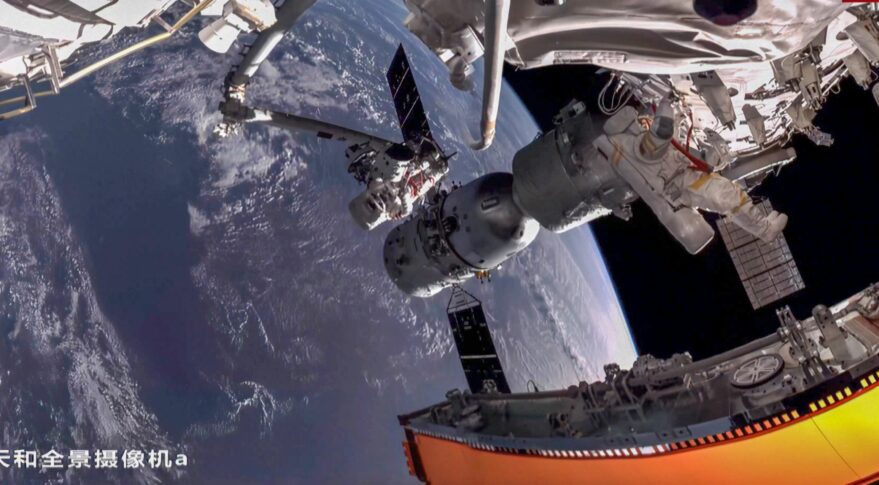
China prepares for July 24 launch of second space station module (Image Credit: Space News)
Hausjärvi, FINLAND — China is gearing up to send a second module to its under-construction space station with a launch from the coastal Wenchang spaceport later this month.
A Long March 5B heavy-lift rocket will launch the roughly 22-ton Wentian experiment module around 02:20 a.m. ET (0620 UTC) July 24, according to recently announced area clearance notices consistent with such a launch.
The 53.7-meter-long, 837.5 metric ton rocket will be rolled out to the pad at Wenchang in the coming days.
Wentian is expected to rendezvous and join Tianhe, the similarly-sized core module for the Tiangong space station which launched in April 2021. Tianhe made orbital adjustments earlier this month to prepare for the arrival of Wentian.
The new module has a length of 17.9 meters and a maximum diameter of 4.2 meters. It features crew quarters and an airlock cabin which will become the main exit-entry point for extravehicular activities (EVAs) once active, replacing the role now played by the Tianhe docking hub.
The new crew facilities will allow China to perform a first crew handover. This will take place when the current Shenzhou-14 crew greet three new astronauts due to fly aboard Shenzhou-15 in December. Tiangong will then host six astronauts for a period of days.
Its main role is hosting experiment racks for science experiments, while also providing backups to the life support and control functions of Tianhe. Wentian carries a five-meter-long robotic arm, supplemental to the 10-meter-long Tianhe arm. The two arms can also join together.
Wentian will also come with 30-meter-long solar arrays, boosting the power available to Tiangong. Wentian will host a new round of live science lectures, following on from those presented by the Shenzhou-13 crew aboard Tianhe.
“Wentian is a critical stage in the building of China’s space station,” says Brian Harvey, author of China in Space: The Great Leap Forward. “The Tianhe crew has overseen numerous undockings and redockings, so such maneuvers are well practiced, but nothing can be taken for granted, especially for the first time.”
The Shenzhou-14 astronauts aboard Tianhe have been undergoing a training program including rendezvous and docking operations and using Tianhe’s mechanical arm in preparation for the arrival of Wentian.
Tianzhou-2, a cargo craft initially charged to deliver supplies to Tianhe for the first crew, Shenzhou-12, was used early this year for a transposition test to verify procedures for moving a module from the forward docking port and towards a lateral port.
Tianhe has so far been visited by three separate three-person crews. The most recent, Shenzhou-14, arrived on June 5 and will oversee the arrival of Wentian and Mengtian, another 22-ton experiment module scheduled for launch in October.
The arrival of the latter will complete the planned T-shaped Tiangong space station, though China has suggested it could later expand the complex to six modules.
“The real work of the station, which we can expect to fly into the 2040s, will begin,” Harvey says, once Mengtian is docked in position.
The Chinese space station was first envisioned in 1992 with the approval of Project 921 which called for the development of human spaceflight capabilities. The project suffered delays due to issues with development and performance of the Long March 5B, but could also be expanded to six modules and most commercial and tourist missions.
The country also plans to launch a co-orbiting optical telescope module, named Xuntian, in late 2023. It will be capable of docking with Tianhe for repairs, maintenance, refueling and upgrades, and aims to survey 40 percent of the sky across a decade.
Xuntian features a two-meter-diameter aperture and a field of view more than 300 times greater than the 32-year-old Hubble Space Telescope. NASA plans a new survey mission, the Nancy Grace Roman Space Telescope, around 2027.
Wentian fallout?
The two previous Long March 5B launches, which carried a test new generation crew spacecraft prototype and the Tianhe module respectively, notably saw the large first stage of the rocket enter orbit and make uncontrolled reentries.
Attention will be on whether or not the launch profile has been altered or deorbiting capabilities, such as restarting engines, have been added. If not, the mission could see another uncontrolled reentry occur. Exceptionally, the Long March 5B includes a core stage and boosters.
Usually smaller second or further stages do the final work to carry a spacecraft into orbit, with the larger first stage cutting off before reaching orbital velocity and falling within a calculated, safe area.
Chinese foreign ministry spokesperson Wang Wenbin stated last year that it was “common practice across the world for upper stages of rockets to burn up while reentering the atmosphere.” In this case, the large first stage is also the upper stage.
While such an event would involve particularly large and massive spacecraft, the standalone threat of the spent rocket stage causing damage or harm will be very low. Most of the stage will burn up in the atmosphere and is likely to land in the oceans or uninhabited areas.
There is however a larger cumulative risk, according to academics, from uncontrolled reentries stemming from space launch activities.
Area clearance notices provide drop zones for the boosters and payload fairings for the upcoming Wentian launch, but no indication of a zone for the first stage.








